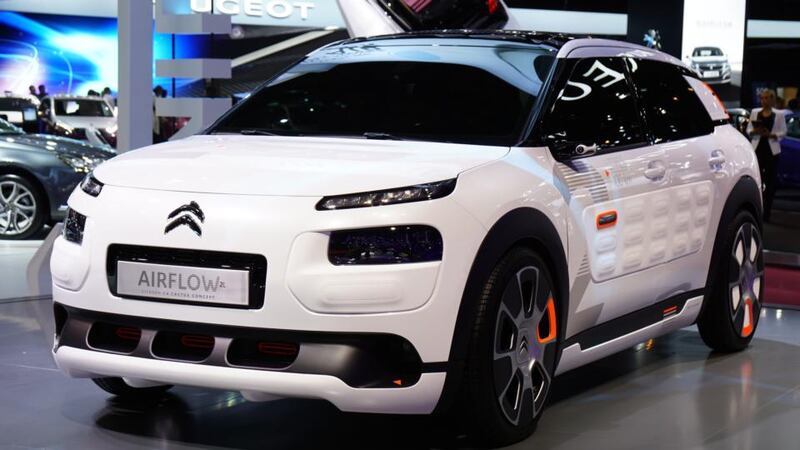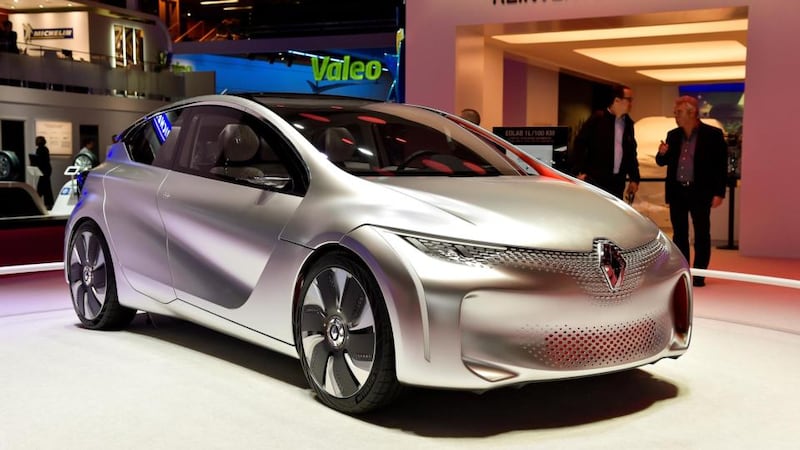The French government has set its national car makers (in which it has quite significant ownership once again) the challenge of putting a car capable of recording fuel consumption of 2.0-litres per 100km (141mpg) on sale. That sounds easy enough you might think - just create a tear-drop-shaped carbon-fibre show pony with a single-sylinder hybrid engine and put it on sale for the doubtless €1-million it cost to build. Ah, but it's tricker. The Elysse Palace says that the car has to be affordable too, oh and there's a 2020 deadline as Europe seeks to cap spiraling transport emissions.
The responses of the three big French car makers are being shown at the Paris Motor Show - one simple, one slightly more exotique and one utterly (but apparently realistically) futuristic.
Peugeot's 208 Hybrid Air is the most reasonbale offering. Based on the exisiting 208 hatchback, it uses the current production 82hp 1.2-litre petrol three-cylinder engine. Instead of batteries or a flywheel, the system stores harvested or excess energy by compressing air into a tank. Turn the valve and the compressed air can drive the car. It can run purely on petrol, purely on air (for very short bursts) or with the two combined. Peugeot claims that the system is more compact, lighter and more affordable than a battery-electric hybrid and it seems committed to bringing the technology to production. Thanks to a weight loss regime, the 208 Hybrid Air helps its consumption and emissions case by weighing just 860kg - significantly lighter than the current production model thanks to the use of exotic (read; expensive) materials.


Sister company Citroen has used the same approach with its Cactus Airflow 2L concept. Based on the just-introduced C4 Cactus compact crossover, the Airflow uses the same 1.2-plus-compressed-air system as the Peugeot, complete with compressed air tank which Citroen claims can be fully refilled (charged, if you like) in just ten seconds. Also like the Peugeot, it does claim to hit the French Government's 141mpg target but Citroen has gone even further down the weight loss regime - taking a car larger than the 208 and reducing it to almost the same kerb weight; 865kg. It also uses trick aerodynamics (including moving aero shutters and screens not activated by heavy electric motors but by simple centrifugal force) to dramatically drop its drag.
Renault, though, has gone a step further than either with its EOLAB concept, which it says is a preview of what a B-segment (or Clio-sized) car could look like in the next decade. In spite of its Star Trek styling, Renault says that the EOLAB's innovations are all more or less production ready. The biggest of these is Renault's first plugin-hybrid drivetrain, which combines a 1.0-litre three-cylinder turbo petrol engine with 75hp and an electric motor fed by the stack of predictable batteries that contributes a further 67hp and 200Nm of torque to the party. Thus equipped, Renault claims to have thoroughly blown away the offical target - the EOLAB is said to be capable of 1.0-litres per 100km, or 282mpg.
Once again, a lot of this is down to the weight and aerodynamics. The EOLAB has ultra-thin windscreen glass, a magnesium roof and a fixed bonnet (hinges and catches are heavy) as well as a drag figure that is said to be 30 per cent better than the current Clio’s.
The fact that it’s a hybrid though could signal a major change of heart from Renault when it comes to electric cars. In spite of a €5-billion investment in the technology, Renault has seen only a trickle of sales for its pure-electric models. Could the EOLAB be not just an answer to a national challenge, but also an acceptance that the public just isn’t ready for battery-only cars just yet?









